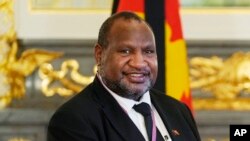The police in the Pacific nation of Papua New Guinea have been authorized to use “lethal force” in response to tribal violence that has killed dozens of people in recent weeks.
Fighting between tribes in Papua New Guinea's northern Enga Province has left up to 70 people dead in the past month, according to police.
A special police unit has been mobilized in response. It has been given the authority to shoot-to-kill if confronted by armed gangs, although rights groups are worried these powers might be too broad and affect farmers, for example, who have a legitimate reason for carrying firearms.
Prime Minister James Marape has described the unrest as domestic terrorism. He told reporters Tuesday that when parliament next convenes in October, he would seek to amend the Tribal Fight Act to impose life prison sentences on people convicted of starting tribal violence.
Acting Superintendent George Kakas, the Enga provincial police commander, told the Australian Broadcasting Corporation's Pacific Beat program that mercenaries are increasingly being paid to fight in local disputes.
"The tribal fights have changed," Kakas said. "We have had tribes that are hiring gunmen and mercenaries to come and do their bidding for them, do their fights for them. A lot of people have been killed. We lost actual count. Some could have been killed in the bush and, you know, buried in the areas in the villages."
Charities say fights are a traditional way to settle disagreements over land and politics in the Highlands of Papua New Guinea but warn they have become more unpredictable and violent.
The International Committee of the Red Cross also said the unrest was caused by "the breaking down of traditional hierarchies and rules, the loss of some traditional values such as respect for women and children, and an influx of modern weapons."
Papua New Guinea is Australia’s nearest neighbor. It covers the eastern half of the island of New Guinea between the Coral Sea and the South Pacific Ocean, and lies to the east of Indonesia.
The country has a population of about 10 million people. It is a rugged land rich in natural resources, but many of its people live in poverty.
It is one of the world’s most linguistically diverse countries. More than 830 indigenous languages are spoken, although many have fewer than 1,000 speakers, according to the CIA’s World Factbook.








